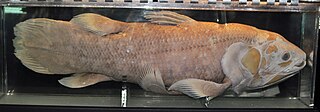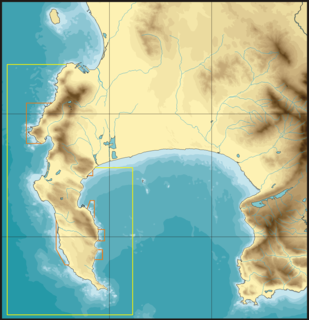
The coelacanths are members of a now-rare order of fish (Coelacanthiformes) that includes two extant species in the genus Latimeria: the West Indian Ocean coelacanth, primarily found near the Comoro Islands off the east coast of Africa, and the Indonesian coelacanth. The name originates from the Permian genus Coelacanthus, which was the first scientifically named coelacanth.

iSimangaliso Wetland Park is situated on the east coast of KwaZulu-Natal, South Africa, about 235 kilometres north of Durban by road. It is South Africa's third-largest protected area, spanning 280 km of coastline, from the Mozambican border in the north to Mapelane south of the Lake St. Lucia estuary, and made up of around 3,280 km2 of natural ecosystems, managed by the iSimangaliso Authority. The park includes:

Latimeria is a rare genus of fish which contains the only living species of coelacanth. It includes two extant species: the West Indian Ocean coelacanth and the Indonesian coelacanth. They follow the oldest known living lineage of Sarcopterygii, which means they are more closely related to lungfish and tetrapods than to the common ray-finned fishes and cartilaginous fishes.

The West Indian Ocean coelacanth is a crossopterygian, one of two extant species of coelacanth, a rare order of vertebrates more closely related to lungfish and tetrapods than to the common ray-finned fishes. The other extant species is the Indonesian coelacanth.

The Aliwal Shoal is a rocky reef which is the remains of an ancient sand dune approximately 5 kilometres (3.1 mi) off the coast of KwaZulu-Natal, South Africa. The reef is inhabited by many kinds of hard and soft corals and other marine invertebrates, and a variety of tropical and subtropical fish species. Aliwal Shoal was named after the near-sinking in 1849 of the three-masted vessel Aliwal, captained by James Anderson. There are two wrecks near the reef that are popular recreational dive sites. The Norwegian bulk carrier MV Produce sank in 1974, and SS Nebo sank in 1884. Aliwal Shoal has diverse marine life, including large predators, and is popular as a recreational scuba diving destination. The Shoal is known especially for its abundance of Grey nurse sharks between July and November when the sharks congregate there to mate.

Shark tourism is a form of eco-tourism that allows people to dive with sharks in their natural environment. This benefits local shark populations by educating tourists and through funds raised by the shark tourism industry. Communities that previously relied on shark finning to make their livelihoods are able to make a larger profit from diving tours while protecting the local environment. People can get close to the sharks by free- or scuba diving or by entering the water in a protective cage for more aggressive species. Many of these dives are done by private companies and are often baited to ensure shark sightings, a practice which is highly controversial and under review in many areas.

Richelieu Rock is a dive site in Thailand in the Andaman Sea about 200 km northwest of Phuket. It is part of the Mu Koh Surin marine park although being about 18 km east of Surin Island.
Protea banks is a reef about 7 km off the shore of South Africa near Margate. The reef is a submerged shoal approximately 6 km long and 800 meters wide, with an average depth of around 30 meters.

Recreational dive sites are specific places that recreational scuba divers go to enjoy the underwater environment or for training purposes. They include technical diving sites beyond the range generally accepted for recreational diving. In this context all diving done for recreational purposes is included. Professional diving tends to be done where the job is, and with the exception of diver training and leading groups of recreational divers, does not generally occur at specific sites chosen for their easy access, pleasant conditions or interesting features.

The Table Mountain National Park Marine Protected Area is an inshore marine protected area around the Cape Peninsula, in the vicinity of Cape Town, South Africa. It was proclaimed in Government Gazette No. 26431 of 4 June 2004 in terms of the Marine Living Resources Act, 18 of 1998.
The marine protected areas of South Africa are in an area of coastline or ocean within the exclusive economic zone (EEZ) of the Republic of South Africa that is protected in terms of specific legislation for the benefit of the environment and the people who live in and use it. An MPA is a place where marine life can thrive under less pressure than unprotected areas. They are like underwater parks, and this healthy environment can benefit neighbouring areas.
The Aliwal Shoal Marine Protected Area is a coastal and offshore marine protected area between the Lovu and Mzimayi estuaries, off the KwaZulu-Natal South Coast, South Africa. The MPA contains the popular scuba diving destination Aliwal Shoal

The Tstsikamma Marine Protected Area is a marine protected area on the south coast of South Africa, in both the Western Cape and Eastern Cape. It is on the coast of the Tsitsikamma National Park, and is one of the oldest MPAs in the country. The MPA provides protection for marine habitat and wildlife, including birds and threatened and endangered fish species.
The Addo Elephant National Park Marine Protected Area is a marine conservation area in Nelson Mandela Bay, Port Elizabeth.
The iSimangaliso Marine Protected Area is a coastal and offshore marine protected area in KwaZulu-Natal from the South Africa-Mozambique border in the north to Cape St Lucia lighthouse in the south.
The Robberg Marine Protected Area is an inshore conservation region in the territorial waters of South Africa, near Plettenberg Bay in the Western Cape province.
The Stilbaai Marine Protected Area is an inshore conservation region in the territorial waters near Stilbaai on the south coast of the Western Cape province of South Africa.

The environmental impact of recreational diving is the effects of recreational scuba diving on the underwater environment, which is largely the effects of diving tourism on the marine environment. It is not uncommon for highly trafficked dive destinations to have more adverse effects with visible signs of diving's negative impacts due in large part to divers who have not been trained to sufficient competence in the skills required for the local environment, an inadequate pre-dive orientation, or lack of a basic understanding of biodiversity and the delicate balance of aquatic ecosystems. There may also be indirect positive effects as the environment is recognised by the local communities to be worth more in good condition than degraded by inappropriate use, and conservation efforts get support from dive communities who promote environmental awareness, and teach low impact diving and the importance of respecting marine life. There are also global coral reef monitoring networks in place which include local volunteer divers assisting in the collection of data for scientific monitoring of coral reef systems, which may eventually have a net positive impact on the environment.
The Sixteen Mile Beach Marine Protected Area is a coastal conservation region in the territorial waters of South Africa, near Saldanha Bay on the Western Cape coast. The MPA is part of the West Coast National Park which is the core component of the Cape West Coast Biosphere Reserve.
Whittle Rock is a granite corestone reef and navigation hazard in False Bay, Western Cape, South Africa. The reef rises from a sandy bottom at about 40 m, to a minimum depth of 3.2 m, and is a well known fishing site and recreational diving area. It has an area of about 1 km2, and can affect the waves at the shore in Kalk Bay in special conditions of a long southeasterly swell. It is marked by a cardinal east buoy with sound and light signals.














